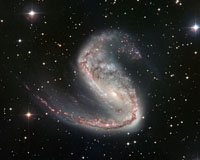 |
Laurel MD (SPX) May 05, 2011 Messenger carries a Gamma-Ray Spectrometer (GRS) that is capable of measuring and characterizing gamma-ray emissions from the surface of Mercury. Just like radio waves, visible light, and X-rays, gamma rays are a form of electromagnetic radiation, but with higher energies than those other types of radiation. Gamma rays coming from Mercury carry information about the concentrations of elements present on its surface, so observations from the Messenger GRS are being used to determine the surface composition of the planet. These results will then be applied to studying the formation and geologic history of Mercury.
Sources of Gamma Rays Stable elements (e.g., iron, silicon, and oxygen) do not spontaneously release gamma rays, so they are not normally detectable with a gamma-ray spectrometer. However, because Mercury lacks a substantial atmosphere, its surface is constantly bombarded by galactic cosmic rays. Cosmic rays are primarily high-energy protons, and when they collide with the surface they produce neutrons that subsequently excite elemental nuclei through such processes as neutron scattering and neutron capture. The normally stable nuclei, converted to unstable "excited states," emit gamma rays to shed the extra energy they received from the neutrons as they return to their stable forms. Each element emits gamma rays at diagnostic energies during this process, enabling the Messenger GRS to determine the surface abundances of such elements from a spectrum of gamma-ray flux versus energy.
The Messenger Gamma-Ray Spectrometer When a gamma ray enters the HPGe crystal, it ionizes germanium atoms, and a measurement of the number of ionized electrons reveals the deposited gamma-ray energy. The ionization signal in the HPGe crystal is very small and can be overwhelmed by the thermal motion of germanium atoms. To reduce this "noise" associated with the thermal motion, the HPGe crystal is cooled to cryogenic temperatures. Such cooling requires that the Messenger GRS instrument include a mechanical cooler and heat radiator in order to keep the crystal temperature near 90 degrees Kelvin (below -300 degrees Fahrenheit). The Messenger GRS is now collecting gamma rays from Mercury's surface in the energy range 1000 to 2000 keV. This energy range includes examples of the two types of gamma rays discussed above. Potassium gamma rays, at an energy of 1460 keV, are emitted during the radioactive decay of potassium atoms. Silicon gamma rays, at an energy of 1779 keV, result from neutron-inelastic-scattering reactions of cosmic rays with silicon atoms. Both types of gamma rays show larger intensities near Mercury and therefore indicate the detection of these elements from Mercury's surface. Other elements within the detection capability of GRS include iron, titanium, oxygen, thorium, and uranium. Converting the measured gamma-ray intensities to elemental concentrations requires a detailed analysis that accounts for factors such as reaction probabilities, detection efficiencies, variable viewing geometries, and background gamma rays. The Messenger Science Team is carrying out these analyses determine the composition of Mercury's surface materials and their implications for planetary formation and evolution.
Share This Article With Planet Earth
Related Links - Space Technology News - Applications and Research
 Two Views of a Lopsided Galaxy
Two Views of a Lopsided GalaxyGarching, Germany (SPX) May 05, 2011 The Meathook Galaxy, or NGC 2442, has a dramatically lopsided shape. One spiral arm is tightly folded in on itself and host to a recent supernova, while the other, dotted with recent star formation, extends far out from the nucleus. The NASA/ESA Hubble Space Telescope and the MPG/ESO 2.2-meter telescope have captured two contrasting views of this asymmetric spiral galaxy. The Meathoo ... read more |
|
| The content herein, unless otherwise known to be public domain, are Copyright 1995-2010 - SpaceDaily. AFP and UPI Wire Stories are copyright Agence France-Presse and United Press International. ESA Portal Reports are copyright European Space Agency. All NASA sourced material is public domain. Additional copyrights may apply in whole or part to other bona fide parties. Advertising does not imply endorsement,agreement or approval of any opinions, statements or information provided by SpaceDaily on any Web page published or hosted by SpaceDaily. Privacy Statement |